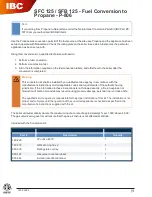
12
WARNING ABOUT CHIMNEY FIRES
Failing to maintain your woodstove or fireplace properly can lead to a
chimney fire. Chimney fires occur when combustible deposits on the inner
walls of the chimney ignite. These combustible deposits, called "creosote,"
are a natural by-product of wood burning. A fire hazard exists if ¼” of
creosote (or more) coats the inner walls of the chimney.
Prevention:
Chimney fires do not occur in clean, intact, properly installed chimneys.
Have a professional chimney sweep clean and inspect your appliance at least once a
year. More frequent cleanings may be required, based on the type of wood burned,
the type of appliance, and the frequency of use. In general, an older, uncertified
woodstove, or any appliance that is used frequently, will require more than one
cleaning per year.
Detection:
The first indication of a chimney fire is usually the noise—a roaring sound
that grows louder as the fire’s intensity increases. Clouds of black smoke and sparks
will be seen exiting the top of the chimney; in severe fires, flames can extend several
feet above the chimney.
Action: In case of a chimney fire, follow these steps:
1.
Call the fire department immediately.
2.
Alert others in the house to evacuate.
3.
Close the appliance’s dampers and/or the primary air inlet controls, limiting the
fire’s air supply and reducing its intensity.
4.
Open the appliance door just enough to insert the nozzle of a 10 lb. dry
chemical fire extinguisher rated for Class ABC fires. Discharge the entire
content of the extinguisher into the appliance and shut the door.
5.
If possible, wet down the roof and other outside combustibles to prevent fires
ignited by shooting sparks and flames.
6.
Closely monitor all combustible surfaces near the chimney. During severe
chimney fires, these surfaces can become hot enough to ignite.
After a chimney fire, have the chimney inspected by a professional chimney sweep or
woodstove/fireplace installer; choose a professional who has earned credentials from
the National Chimney Sweep Guild at www.ncsg.org, Chimney Safety Institute at
www.csia.org or the Hearth Education Foundation at www.hearthed.com.
Contact your insurance carrier.
DO NOT USE THE CHIMNEY UNTIL A PROFESSIONAL HAS INSPECTED IT.
The excessive heat produced by a chimney fire can crack chimney walls, damage
chimney liners, and damage some types of factory-built chimneys. If not repaired,
these damages create a greater possibility for any subsequent chimney fire to spread
beyond the confines of the flue to the house.
Summary of Contents for Pinnacle PB150
Page 4: ...3 SPECIFICATIONS Figure 1...
Page 14: ...13 Figure 3...
Page 16: ...15 Figure 5...
Page 17: ...16 Figure 6...
Page 30: ...29 NOTES...














































